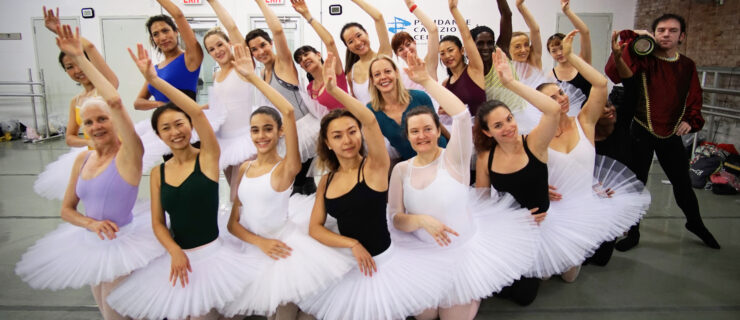Planning Plan B: How to Bounce Back If Your Top-Choice College Doesn't Accept You
This story originally appeared in the October/November 2015 issue of Pointe.
Kristin Young’s family is a legacy at Indiana University. While they weren’t dancers, both her mother and her sister had attended IU, and she grew up near Indianapolis making regular pilgrimages to Bloomington for sports events. So when the rejection to IU’s highly competitive ballet program came, it was a huge blow. “I always thought that I would either go to IU or straight into the professional ballet world,” says Young, who is now an apprentice with Nashville Ballet. Luckily, she was careful to apply to several universities. When she was accepted to the University of Oklahoma, she began imagining a different path.
Attending college before a professional ballet career has become a legitimate option for dancers. But because there aren’t as many ballet-focused dance programs, serious bunheads tend to only consider a few. If you’ve got your sights set on just one or two schools, the competition can be as fierce as any company audition. But getting rejected from your preferred college doesn’t have to be the end of the world. By researching all the options available to you, and planning your audition process strategically, you can improve your chances of getting into a good second- or third-choice school. Plan B may even end up being the best thing that ever happened to you.
Cast a Wide Net
 Photo by Bonnie Kittle via Unsplash
Photo by Bonnie Kittle via Unsplash
In this information age, we have multiple resources at our fingertips for researching all the possibilities. First, make a list of the things that are most important to you in a university setting and then do your homework to find colleges with ballet-focused programs that meet those criteria. To get an idea of what’s out there, you might begin by searching universities and colleges through the Dance Magazine College Guide.
Young wanted the full college experience, complete with football games and Greek life. For this reason she focused on larger schools with robust athletic departments and reputable ballet programs. Even with her specific criteria she homed in on three—IU, Butler University and OU—instead of putting all her eggs in one basket.
As for dance programs, look for a diversity of high-caliber teachers. Performance opportunities should also be paramount in your decision-making. “I grew up in a school affiliated with a professional company, so I did children’s roles or corps roles in high school,” recalls Young. The opportunity to perform soloist and principal roles at OU was particularly attractive to her.
When you are narrowing down schools, do more than skim its website—especially for programs you’re not as familiar with. Call the department and ask questions, and look for YouTube videos of their performances, or news features about their programs. Schools may offer surprising extras not publicized online, such as touring, study abroad and internship opportunities.
From there, Mercyhurst University Dance Department chair Tauna Hunter suggests narrowing your list to at least three to five colleges to see in person. “Visit while the school is in session, not during the summer,” she advises. “See how the faculty interacts with the students.” In this process, you may find that the school of your dreams isn’t quite the right fit and discover others that surprise you.
Make a Plan
 Getty Images
Getty Images
Next, organize an audition strategy. Scheduling them early in the year gives you time to plan more if you receive a rejection. You may even want to get your feet wet at a plan-B college before trying for your top choice. Young, who auditioned at IU first, admits that she was nervous and not in her best ballet shape. “I think getting that audition under my belt gave me the confidence to shine in my next one, which happened to be at OU,” she says.
That said, if you didn’t perform your best, schools may allow you to audition again for the same academic year. Mary Margaret Holt, director of OU’s School of Dance, says dancers who are not successful at the October audition will often try again in January. If your first-choice school offers multiple audition opportunities, try scheduling one early enough so that you can request another later if necessary.
If you’re wait-listed for your favorite college, it’s hard to predict if you’ll ever make it off. Therefore, don’t let deadlines pass before accepting a place at your backup school. Hunter says that most colleges have their incoming class set by May 1. However, it is permissible, if you’re accepted off the wait list, to pull out of another program (although you may lose a deposit). Hunter advises that dancers be forthcoming as soon as they decide to go someplace else. Doing so isn’t just polite—it’s also important to protect your network, since the dance world is so small.
Be Open to a Different Path
 Photo by Element5 Digital via Unsplash
Photo by Element5 Digital via Unsplash
While getting rejected from your first-choice college is understandably upsetting, it won’t hurt to ask for feedback. Holt is happy to discuss with students why they’ve been rejected and suggest other programs that might be a better fit.
In addition, try focusing on the opportunities available to you rather than those that aren’t. After getting rejected from IU, Young got over her disappointment by seizing the opportunity to leave her comfort zone and move to a new city.
“I absolutely thrived at Oklahoma,” says Young. “It was the perfect place for me.” She graduated in three and a half years and, thanks to a recommendation from Holt, immediately joined Tulsa Ballet as a guest artist for their production of Twyla Tharp’s Push Comes to Shove. She started the following season with Nashville Ballet 2 before being promoted to apprentice last year. “Don’t be discouraged if you don’t get into your favorite school,” she says. “Something better could be around the next corner.”






